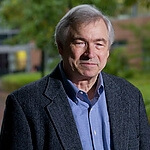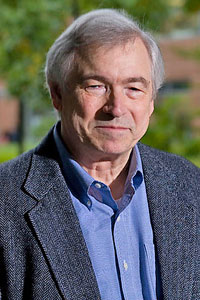News
James R. Rice is Professor of Engineering Sciences and Geophysics in the School of Engineering and Applied Sciences (SEAS) and the Department of Earth and Planetary Sciences (EPS) at Harvard.
The 2012 Louis Néel Medal has been awarded to James R. Rice for his seminal contributions to the fundamental understanding of strain localization, poromechanics, and friction.
The award committee praised his elegant and systematic studies that have elucidated fault mechanics and the coupling with hydrologic and thermal processes during all phases of the earthquake cycle.
This medal, given on behalf of the European Geosciences Union, is reserved for individuals in recognition of outstanding achievements in rock magnetism and rock physics and geomaterials.
Rice, Mallinckrodt Professor of Engineering Sciences and Geophysics in the School of Engineering and Applied Sciences (SEAS) and the Department of Earth and Planetary Sciences (EPS) at Harvard, is widely recognized, according to the EGU award announcement, as the world’s leading researcher in solid mechanics over the last four decades,having contributed so broadly not only in engineering, but also in geosciences.
His early contributions in the areas of solid mechanics and materials science include the theory of crack propagation inelastic-plastic material, mechanics of void formation and ductile fracture, as well as formulation of inelastic constitutive relations.
Rice's invention of the path-independent J-integral forms the basis for the practical application of nonlinear fracture mechanics to the development of standards for the safety of structures. Since the 1970s, he has shifted his research interest to also focus on fundamental mechanics problems that arise in seismology, tectonophysics, and geomechanics.
In rock physics, he and his students have made seminal contributions in the mechanics of strain localization, poroelasticity,and the coupling of deformation and fluid flow, as well as constitutive modeling of rock friction and instability.
The models of earthquake instability formulated to study these effects were among the first in which the instability was not postulated but arose in a mechanically consistent way from the interaction of the fault zone material behavior and the surroundings. For over two decades this constitutive framework has had significant impact on the mechanical analysis of all aspects of the earthquake cycle.
Rice’s seismological studies have elucidated the mechanics of the nucleation of rupture, thermo- and hydromechanical weakening of fault zones during seismic slip, slip patterns and complexity, postseismic deformation and aseismic creep, fracture propagation through branched and offset fault systems, as well as glacial earthquakes.
He received his B.Sc, M.Sc., and Ph.D. degrees all from Lehigh University. Prior to coming to Harvard, he was a faculty member at Brown University. Rice's numerous honors include include elected fellowships of the American Academy of Arts and Sciences, the American Society of Mechanical Engineers, and the American Geophysical Union, and memberships in the National Academy of Engineering and the National Academy of Sciences. He is also a Foreign Memberof the Royal Society of London and the Académie des Sciences, Institut de France. He has received several honorary doctorate degrees, most recently from Université Joseph Fourier, Grenoble, in January 2012 recognizing his contributions to geophysics and mechanics.
Rice will receive the medal at a ceremony held at the meeting of the European Geosciences Union on April 24 in Vienna.
###
About the Louis Néel Medal
This medal has been established by the Division on Magnetism, Palaeomagnetism and Rock Physics in recognition of the scientific achievements of Louis Eugène Felix Néel, who shared the 1970 Nobel Prize of Physics for his fundamental research and discoveries concerning antiferromagnetism. This medal is reserved for individuals in recognition of outstanding achievements in rock magnetism and rock physics and geomaterials.
This release was adapted from a statement from the European Geosciences Union.
Cutting-edge science delivered direct to your inbox.
Join the Harvard SEAS mailing list.
Scientist Profiles
James R. Rice
Mallinckrodt Professor of Engineering Sciences and Geophysics, Emeritus

